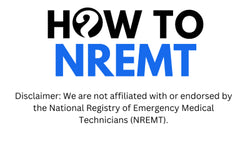If you’ve already started prepping for the NREMT in 2025, you’ve probably heard the news: the exam format just changed. Cue the panic, right? Not so fast.
As of April 7, 2025, the National Registry officially rolled out a new structure for the NREMT cognitive exam across EMR, EMT, AEMT, and Paramedic levels. With updated domains, integrated pediatric content, and high-tech question formats, it’s natural to wonder:
“Will I need to change my study strategy—or worse, start over?”
The good news? You won’t lose your progress. But that doesn’t mean you can ignore the shift either. In this article, we’ll break down exactly what the NREMT exam transition means for current students, what’s changed, what hasn’t—and how to stay on course without burning out or falling behind.
What’s Actually Changed in 2025?
The 2025 NREMT update isn’t just cosmetic—it’s a shift in how the exam reflects real-life EMS care. Let’s break down what’s new so you know exactly what to expect.
1. New Content Domains
Out with the old categories like “Airway” and “Cardiology.” The NREMT has introduced broader, more scenario-driven domains. For example:
·Primary Assessment now has the highest weight, especially for EMTs
·Pediatric questions are no longer a separate domain—they’re embedded throughout
·Greater focus on scene safety, patient interaction, and critical thinking
Translation? You need to be ready to prioritize care and make field decisions, not just memorize protocols.
2. Technology-Enhanced Items (TEIs)
The NREMT has expanded its use of tech-forward question formats. These may include:
·Drag-and-drop questions for triage or protocol steps
·Table classification (e.g., match symptoms to age groups)
·Build-list questions (prioritizing actions in order)
·Multiple-select items—yes, more than one answer can be correct
These aren’t just for Paramedics anymore—even EMTs and EMRs will see them.
3. Pediatric Integration
Pediatric care is now fully embedded across all domains, particularly in the Primary Assessment and Medical/Trauma Management sections. You may not get a dedicated “peds” section, but you’ll definitely get pediatric content.
4. Psychomotor Testing
For EMTs and EMRs, no change—you’ll still need to pass the skills exam through your program. For AEMTs and Paramedics, the national psychomotor exam has been discontinued, but some states may still require it locally.
This update isn’t about making things harder—it’s about making the exam more realistic. And that’s something your NREMT prep strategy should reflect.

Do You Have to Retest or Start Over?
Let’s clear this up right away:
No, you don’t have to start over just because the NREMT changed.
If you’ve already begun studying, taken a prep course, or even attempted the exam before April 7, you’re still on track. Your eligibility and application status remain valid. But here’s what you do need to consider:
1. Application Status Still Matters
·If your NREMT application is active, you can continue preparing without interruption.
·If it’s expired, you may need to reapply under the new test structure—so check your account dashboard.
·Already failed once or twice? You’ll still get up to six attempts within your two-year eligibility window—no reset required.
2. You Don’t Need to Re-Train
There’s no requirement to repeat your EMT course or attend a new class. But it’s smart to update your prep materials so they reflect the new domain structure and TEI formats.
This is where working with an NREMT prep tutor or using an updated NREMT prep course can make all the difference. They’ll help you adapt quickly—without wasting time on outdated content.
So, no—your hard work hasn’t been for nothing. But moving forward blindly could cost you points you can’t afford to lose.

Why the Old Study Habits May Not Cut It Now
Still using flashcards and watching YouTube walkthroughs? That’s a start—but with the 2025 changes, it may not be enough.
1. New Format, New Thinking
This isn’t just about facts—it’s about decision-making in motion. The updated NREMT exam challenges you to:
·Prioritize actions in complex scenarios
·Interpret pediatric signs across age groups
·Navigate interactive question types that mimic real EMS judgment calls
The shift to Technology-Enhanced Items means you’re not just choosing A, B, C, or D—you might need to rank, match, drag, or classify.
2. Critical Thinking Over Rote Memorization
In the past, memorizing vitals or algorithms may have gotten you by. Now, you’ll be asked:
·“What’s the next best step?”
·“Which of these three signs confirm your suspicion?”
·“Which patients should you treat first in this multi-casualty scene?”
You need to train your brain to respond like a provider, not a test-taker.
3. Updated Practice Is Key
This is where tools like a practice NREMT test or targeted EMT tutoring come into play.
Working with an experienced NREMT tutor who understands the 2025 blueprint can help you shift from passive review to real exam prep that sticks.
Bottom line: You don’t need to study harder—you need to study smarter.
Adapting Your Strategy for the New Blueprint
You’ve got the ambition. Now you need the right map.
The 2025 NREMT exam transition has introduced a new test blueprint that’s more aligned with how EMS providers operate in the field. So, how do you adapt your study plan to match?
1. Start with Domain-Based Study
The old checklist-style review won’t cut it. Focus instead on the four core domains outlined in the new blueprint:
·Primary Assessment
·Medical/Trauma Management
·Resuscitation & Ventilation
·EMS Operations
Prioritize Primary Assessment—it now carries the most weight, especially for EMT candidates.
2. Don’t Ignore Pediatrics
Pediatric scenarios are now scattered across the entire exam—not grouped in one place. That means you must know:
·Age-based vital signs
·Pediatric trauma decision-making
·Respiratory distress cues in infants and children
A solid paramedic tutor or updated NREMT prep course will ensure you’re practicing with realistic pediatric crossover cases.
3. Practice Interactive Formats
TEIs are here to stay. If you’re not practicing drag-and-drop or multi-select formats, you’re not preparing realistically.
Use tools that offer NREMT cognitive exam practice with these formats built in. The goal is to build fluency so you’re not wasting time figuring out how to answer when it counts.
4. Lean on Experts
Working with EMT tutors or enrolling in an NREMT test prep program that’s been revised for 2025 can give you the edge. Many now offer:
·Domain-based practice
·TEI-style quizzes
·Pediatric scenario walkthroughs
·Personalized guidance to refine your strategy
The exam may have changed—but with the right prep, your outcome doesn’t have to.

What About Students Reapplying or Retaking in 2025?
If you didn’t pass on your first try—or if your application expired—you might be wondering: “Do I fall under the old rules or the new ones?”
The short answer: If you test after April 7, 2025, you’ll take the updated exam—regardless of when you started.
1. Reapplying? Start Fresh with Updated Materials
Even if you completed an EMT course last year, your next test attempt will follow the new domain structure and TEI formats. That means:
·The same content knowledge still applies
·But you’ll need to study with updated tools that reflect the 2025 format
We recommend switching to an NREMT prep program or working with a paramedic NREMT prep tutor who’s already coached students through the transition.
2. Retaking the Exam? Adjust Your Focus
If you’ve failed once or twice already, the 2025 version of the test will look and feel different—even if the topics are familiar. What this means for you:
·You must practice the new item types (especially multi-select, drag-and-drop, and build-lists)
·Brush up on Primary Assessment and pediatric integration, which now carries more weight
·Don’t rely on what you saw the first time—the structure and scoring logic have shifted
This is your chance to come back stronger—not more confused.
You’re not starting from scratch, but you are stepping onto a new playing field. And with the right prep, you can still win.
Common Mistakes to Avoid During the Transition
The worst mistake you can make during the 2025 NREMT exam transition? Studying like it’s still 2024.
Here are the top pitfalls—and how to dodge them:
1. Using Outdated Study Materials
If your prep book or quiz app doesn’t mention the new domains or TEI formats, it’s probably outdated. That means:
·You’re not seeing pediatric questions in every section
·You’re not practicing the new interactive item types
·You’re wasting time memorizing lists instead of thinking like a provider
Stick with tools aligned with the 2025 blueprint and tested by NREMT prep experts.
2. Ignoring Format-Specific Practice
Just knowing the content isn’t enough. Students often underestimate how different interactive question types feel under pressure.
Solution? Take practice NREMT tests that simulate the real test experience—clicks, timing, and all.
3. Studying in a Vacuum
Too many students grind alone, guessing what matters most. But NREMT test preparation isn’t just about what you know—it’s how you apply it.
Consider joining a study group or working with an NREMT prep tutor who understands the updated scoring and domain focus.
Avoid these traps, and you’ll be ahead of the game—while everyone else is still trying to catch up.

Need Help Adjusting to the 2025 NREMT Format? We’ve Got You.
Whether you’re retesting, reapplying, or tackling the exam for the first time, the new NREMT format doesn’t have to throw you off. At How To NREMT, we specialize in up-to-date support that’s built around the current exam—not last year’s version.
Personalized help from expert NREMT prep tutors
Practice tools that match the 2025 exam structure
Smart strategies for tackling pediatric integration and TEI questions
Want rapid results? Sign up for our 7 or 14-Day NREMT Boot Camp via Zoom. The next session runs July 7–20, 2025, and includes separate EMT and Paramedic tracks.
Limited spots. 50% off. Reserve your seat today and get the expert help you need to pass confidently.

